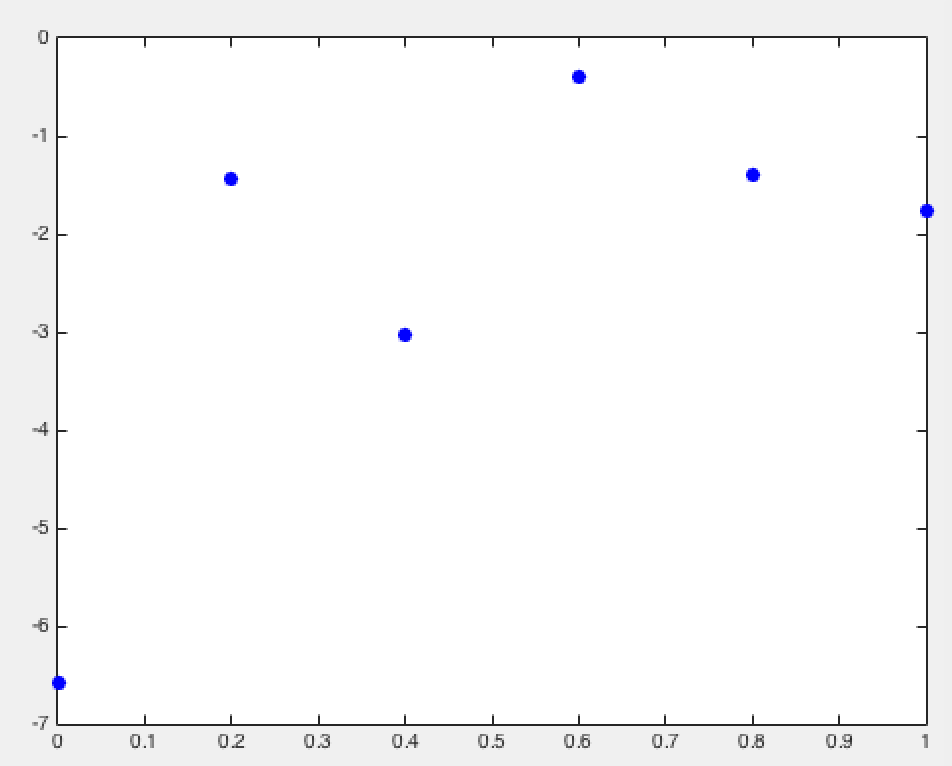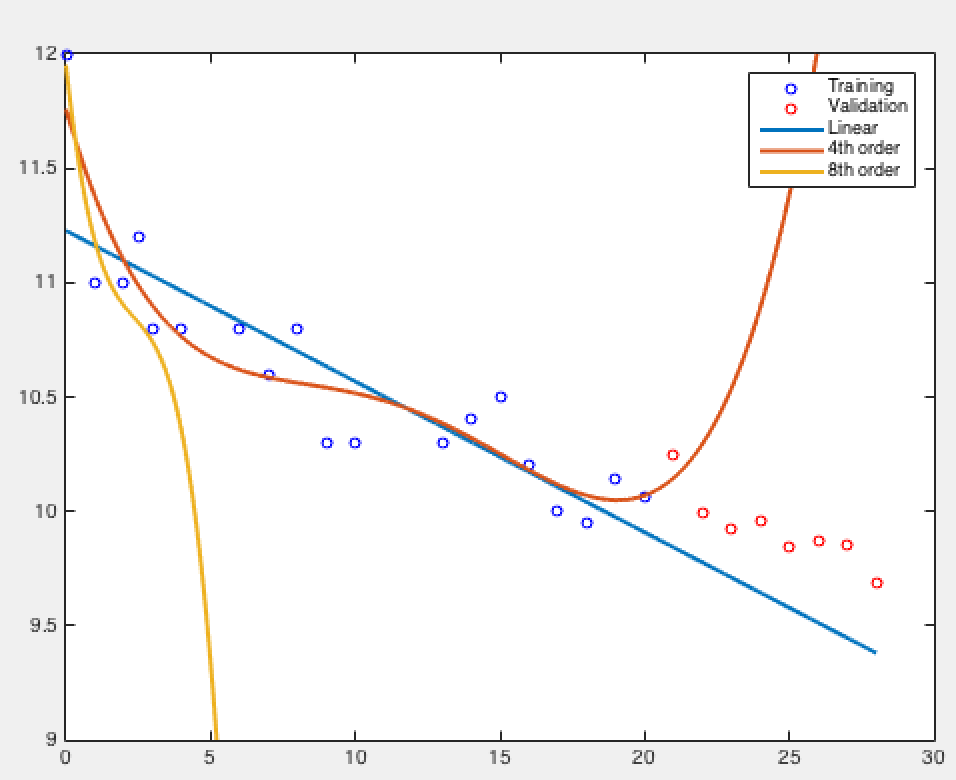ML基礎教程:泛化與過擬合、正規化最小二乘法
阿新 • • 發佈:2019-02-03
泛化與過擬合
olympval.m
Load the Olympic data and extract the training and validation data
load data/olympics
x = male100(:,1);
t = male100(:,2);
pos = find(x>1979);
% Rescale x for numerical reasons
x = x - x(1);
x = x./4;
valx = x(pos:end);
valt = t(pos:end);
x(pos:end) = [];
t(pos:end) = [];Fit the different models and plot the results
orders = [1 4 8]; %We shall fit models of these orders
% Plot the data
figure(1);hold off
plot(x,t,'bo','markersize',5);
hold all
plot(valx,valt,'ro','markersize',5);
plotx = [min(x):0.01:max(valx)]';
for i = 1:length(orders)
X = [];
plotX = [];
valX = [];
for k = 0:orders(i)
X = [X x.^k] Display the validation losses
for i = 1:length(orders)
fprintf('\n Model order: %g, Validation loss: %g',...
orders(i),val_loss(i));
endModel order: 1, Validation loss: 0.101298
Model order: 4, Validation loss: 4.45706
Model order: 8, Validation loss: 3.72921e+07
cv_demo.m
Generate some data
Generate x between -5 and 5
N = 100;
x = 10*rand(N,1) - 5;
t = 5*x.^3 - x.^2 + x + 150*randn(size(x));
testx = [-5:0.01:5]'; % Large, independent test set
testt = 5*testx.^3 - testx.^2 + testx + 150*randn(size(testx));Run a cross-validation over model orders
maxorder = 7;
X = [];
testX = [];
K = 10 %K-fold CV
sizes = repmat(floor(N/K),1,K);
sizes(end) = sizes(end) + N - sum(sizes);
csizes = [0 cumsum(sizes)];
% Note that it is often sensible to permute the data objects before
% performing CV. It is not necessary here as x was created randomly. If
% it were necessary, the following code would work:
% order = randperm(N);
% x = x(order); Or: X = X(order,:) if it is multi-dimensional.
% t = t(order);
for k = 0:maxorder
X = [X x.^k];
testX = [testX testx.^k];
for fold = 1:K
% Partition the data
% foldX contains the data for just one fold
% trainX contains all other data
foldX = X(csizes(fold)+1:csizes(fold+1),:);
trainX = X;
trainX(csizes(fold)+1:csizes(fold+1),:) = [];
foldt = t(csizes(fold)+1:csizes(fold+1));
traint = t;
traint(csizes(fold)+1:csizes(fold+1)) = [];
w = inv(trainX'*trainX)*trainX'*traint;
fold_pred = foldX*w;
cv_loss(fold,k+1) = mean((fold_pred-foldt).^2);
ind_pred = testX*w;
ind_loss(fold,k+1) = mean((ind_pred - testt).^2);
train_pred = trainX*w;
train_loss(fold,k+1) = mean((train_pred - traint).^2);
end
endK =
10
Plot the results
figure(1);
subplot(311)
plot(0:maxorder,mean(cv_loss,1),'linewidth',2)
xlabel('Model Order');
ylabel('Loss');
title('CV Loss');
subplot(312)
plot(0:maxorder,mean(train_loss,1),'linewidth',2)
xlabel('Model Order');
ylabel('Loss');
title('Train Loss');
subplot(313)
plot(0:maxorder,mean(ind_loss,1),'linewidth',2)
xlabel('Model Order');
ylabel('Loss');
title('Independent Test Loss')正規化最小二乘法
An example of regularised least squares Data is generated from a linear model and then a fifth order polynomial is fitted. The objective (loss) function that is minimisied is
Generate the data
x = [0:0.2:1]';
y = 2*x-3;Create targets by adding noise
noisevar = 3;
t = y + sqrt(noisevar)*randn(size(x));Plot the data
plot(x,t,'b.','markersize',25);
Build up the data so that it has up to fifth order terms
plotX = [0:0.01:1]';
X = [];
plotX = [];
for k = 0:5
X = [X x.^k];
plotX =[plotX plotx.^k];
endFit the model with different values of the regularisation parameter
lam = [0 1e-6 1e-2 1e-1];
for l = 1:length(lam)
lambda = lam(l);
N = size(x,1);
w = inv(X'*X + N*lambda*eye(size(X,2)))*X'*t;
figure(1);hold off
plot(x,t,'b.','markersize',20);
hold on
plot(testX,TestX*w,'r','linewidth',2)
xlim([-0.1 1.1])
xlabel('$x$','interpreter','latex','fontsize',15);
ylabel('$f(x)$','interpreter','latex','fontsize',15);
ti = sprintf('$\\lambda = %g$',lambda);
title(ti,'interpreter','latex','fontsize',20)
end

